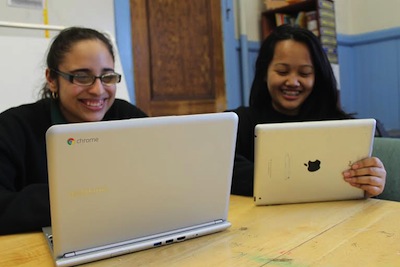Whether you’re a teacher or an administrator, you may be asking yourself, “Chromebooks or iPads for my classroom?” If a school is looking to go 1:1, which one is the better choice? This hotly-debated question peppers the educational landscape as districts seek to invest money in devices that will engage and enhance student learning.
Although iPads and Chromebooks target the same industry, they are marketed in different ways. iPads are positioned as recreational tools with a variety of apps, while Chromebooks boast a professional appeal with business-oriented programs.
But what if they crossed the enemy line, and instead, worked together?
In my experience, iPads and Chromebooks fulfill different needs, and it’s ultimately up to the school/district to decide which is best suited for their school model and learning environment. But that doesn’t mean they cannot co-exist in harmony. As a Technology Integration Specialist, I’ve used both devices in school settings and observed how each one functions in a learning environment.
This year, I encouraged my school to integrate both iPads and Chromebooks into the classroom, as the only school in Rhode Island currently adopting a hybrid model of both devices. As a 7th-12th grade arts-integration school, we decided to dedicate the iPads to the middle school and the Chromebooks to the high school. The result? Innovation at its finest.
First, let’s take a quick look at the unique advantages that each device has to offer.
iPads: The Popular Kid
Apps
iPads offer a multitude of apps that is unparalleled by other devices. The App Store covers everything from music to science to lifestyle apps. Educational apps are conveniently separated into grade levels and content areas, and are frequently featured on the main page, which leads them to be ever-changing with the newest and best. Whether it be the newest release from Motion Math Games, an interactive presentation from Nearpod, or new monsters on behavior-tracking system Class Dojo, the App Store delivers the latest innovations.
Functionality
Creativity and innovation are where the iPad thrives. Students can use the iPad to draw models of a solar system using the multi-touch display in Sketchbook Pro, a professional-grade drawing application. The iPad can turn into a full-featured recording studio, where students can produce a song about William Shakespeare using the built-in microphone and instruments in GarageBand. Or why not combine drawing and sound in Educreations and have student create videos of themselves explaining linear equations? Creation pushes students to the top of Bloom’s Taxonomy and helps them develop critical higher-order thinking skills.
Usability
iPads are designed for any age, and are particularly successful with elementary students. The large touchscreen allows students with developing motor skills to interact with the device. As students get older, the apps become more targeted towards grade levels and accordingly adjust the level of touch detail. Elementary school apps may have larger objects and spaces for drawing, while high school applications feature finer elements and finger precision.
Chromebooks: The Overachiever
Apps
The best way to launch Chromebooks in a school is to implement Google Apps for Education (GAFE). This platform allows students to have their own unique user accounts, which they can access from any device that they sign into. GAFE also makes it easy to manage devices, add Google tools, and push out apps to students. In class, students can download apps from the Chrome Web Store, which offers numerous educational apps and all reside in the cloud. While the iPad App Store has a wide range of apps, the Chrome Web Store is more focused on educational and productivity apps geared towards academia and business.

Functionality
Sleek, light, and powerful, Chromebooks are essentially mini-computers. Students can take advantage of the cloud-based system and use Chromebooks for conducting research, typing papers, and collaborating with group members. The professional nature of the laptops prepares students for a collegiate and career-oriented setting, as opposed to the recreational nature of the iPads positioned towards a leisurely setting.
Usability
The key feature of Chromebooks is that everything is stored and accessed online, which means an Internet connection is necessary to use the device. Students can also utilize Google’s offline mode in the event of limited wireless connection, which is hugely helpful for schools with touchy Internet. Students can continue to draft documents or write emails, and once the device is back online, the drafts are synced automatically. Everything on Chrome integrates seamlessly with Google’s single sign-on (SSO) – once a student turns on any device and enters their Google account, their email, documents, apps, music, and more are immediately available.
A Chromebook-iPad Hybrid Model
Clearly, iPads and Chromebooks each have their own appeal -- but when paired together, the resulting hybrid model can provide quite the package to an innovative and multi-level school. Integrating both devices into classrooms allows for flexibility of teaching and learning, and exposes students to various ways of accessing information and creating content. Students also develop much-needed 21st Century Skills, with collaboration, critical thinking, and digital literacy coming into play as they explore new ways to integrate devices into their learning.

The iPads have been particularly successful with the younger students, which can take advantage of the interactive apps closely tied to their curriculum and engage with material on a deeper level. They also use the iPads to create and innovate as they begin their journey into foundational art forms. As one 8th grade student explains, “The iPads are awesome to have in class. I can take pictures, make music, write notes, and play science games. They are also easy to carry around and help me get my work done faster!”
Moving on up, the high school students have greatly appreciated the Chromebooks as they begin to prepare for higher education. The keyboard makes it quicker to type lengthy essays, Google Drive makes it easier to collaborate with group members, and the cloud-based system makes it simpler to manage assignments. A 9th grade freshman who previously used iPads states, “I really enjoy using the Chromebooks. I can type quicker, stay organized, and personalize my Google account. I feel like I’m in college.”
Clearly, iPads and Chromebooks both come with their unique advantages for and benefits to the educational landscape. As we’ve seen, both are effective in meeting students’ needs, as well as differentiating for age and learning levels of students. The key factor, however, is that both are ultimately changing the ways in which classrooms in today’s society function – through creation, collaboration, and innovation. And so, instead of choosing one or the other -- why not harness the power of both?


